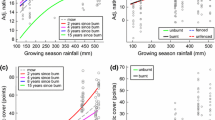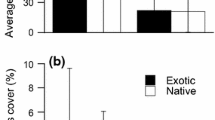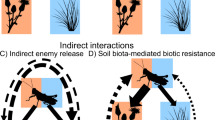Abstract
Consumer-facilitated invasions have been proposed as an alternative mechanism to direct competitive exclusion to explain the replacement of native plants by exotics. In a factorial field experiment manipulating competition from the exotic plant Alliaria petiolata and herbivory by exotic mollusks, we documented that mollusk herbivory significantly reduced the survival of two species of native palatable plants, but found minimal direct herbivore effects on less palatable species, including the invasive A. petiolata. These effects were evident after one growing season on younger juvenile plants of Aster cordifolius, but only after two growing seasons on older transplants of the same species, suggesting a greater vulnerability of young plants. In contrast to our expectations, A. petiolata competition alone had no effect on any of the six native species we tested. However, competition from A. petiolata did affect the survival of the most palatable native plant when mollusks were also present. While not significant for any other single species, this same pattern was observed for three of the five remaining native species tested. The selective grazing on palatable plants that we document provides novel evidence contributing to our understanding of observed shifts in the forest herbaceous layer towards the dominance of exotic plants and unpalatable species. More broadly, our results highlight the importance of the interactive effect of consumers and inter-specific competition in forest understories via its contribution to differential survival among regenerating species.




Similar content being viewed by others
References
Anderson RC, Dhillion SS, Kelley TM (1996) Aspects of the ecology of an invasive plant, garlic mustard (Alliaria petiolata), in central Illinois. Restor Ecol 4:181–191
Brudvig LA, Mabry CM, Mottl LM (2011) Dispersal, not understory light competition, limits restoration of Iowa woodland understory herbs. Rest Ecol 19:24–31
Burke DJ (2008) Effects of Alliaria petiolata (garlic mustard, Brassicaceae) on mycorrhizal colonization and community structure in three herbaceous plants in a mixed deciduous forest. Am J Bot 95:1416–1425
Buschmann H, Edwards PJ, Dietz H (2005) The effect of slug grazing on vegetation development and plant species diversity in an experimental grassland. Funct Ecol 19:291–298
Byers JE, Reichard S, Randall JM et al (2002) Directing research to reduce the impacts of nonindigenous species. Cons Biol 16:630–640
Callaway RM, Cipollini D, Barto K et al (2008) Novel weapons: invasive plant suppresses fungal mutualists in America but not in its native Europe. Ecol 89:1043–1055
Chase JM, Abrams PA, Grover JP et al (2002) The interaction between predation and competition: a review and synthesis. Ecol Lett 5:302–315
Chesson P, Kuang JJ (2008) The interaction between predation and competition. Nature 456:235–238
Chichester LF, Getz LL (1973) The terrestrial slugs of Northeastern North America. Sterkiana 51:11–42
Cipollini D (2004) Stretching the limits of plasticity: can a plant defend against both competitors and herbivores? Ecology 85:28–37
Cipollini D, Mbagwu J, Barto K, Hillstrom C, Enright S (2005) Expression of constitutive and inducible chemical defenses in native and invasive populations of Alliaria petiolata. J Chem Ecol 31:1255–1267
Curtis JT (1959) The vegetation of Wisconsin. University Wisconsin Press, Madison, WI
Didham RK, Tylianakis JM, Hutchinson MA, Ewers RM, Gemmell NJ (2005) Are invasive species the drivers of ecological change? Trends Ecol Evol 20:470–474
Eschtruth AK, Battles JJ (2009) Acceleration of exotic plant invasion in a forested ecosystem by a generalist herbivore. Cons Biol 23:388–399
Fenner M (1987) Seedlings. New Phytol 106:35–47
Gonzales EK, Arcese P (2008) Herbivory more limiting than competition on early and established native plants in an invaded meadow. Ecol 89:3282–3289
Gurevitch J, Padilla DK (2004) Are invasive species a major cause of extinctions? Trends Ecol Evol 19:470–474
Hahn PG, Draney ML, Dornbush ME (2011) Exotic slugs pose a previously unrecognized threat to the herbaceous layer in a Midwestern woodland. Rest Ecol doi:10.1111/j.1526-100X.2010.00710.x
Hanley ME, Sykes RJ (2009) Impacts of seedling herbivory on plant competition and implications for species coexistence. Annals Bot 103:1347–1353
Hanley ME, Fenner M, Edwards PJ (1995a) An experimental field study of the effects of mollusc grazing on seedling recruitment and survival in grassland. J Ecol 83:621–627
Hanley ME, Fenner M, Edwards PJ (1995b) The effects of seedling age on the likelihood of herbivory by the slug D. reticulatum. Funct Ecol 9:754–759
Hawkins JW, Lankester MW, Nelson RRA (1998) Sampling terrestrial gastropods using cardboards sheets. Malacologia 39:1–9
Herms DA, Mattson WJ (1992) The dilemma of plants: to grow or defend. Quart Rev Biol 67:283–335
Hobbs RJ et al (2006) Novel ecosystems: theoretical and management aspects of the new ecological world order. Glob Ecol Biogeogr 15:1–7
Hochstedler WW, Slaughter BS, Gorchov DL, Saunders LP, Stevens MHH (2007) Forest floor plant community response to experimental control of the invasive biennial, Alliaria petiolata (garlic mustard). J Torr Bot Soc 134:155–165
Holland KD, McDonnell MJ, Williams NSG (2007) Abundance, species richness and feeding preferences of introduced molluscs in native grasslands of Victoria, Australia. Austral Ecol 32:626–634
Joe SM, Daehler CC (2008) Invasive slugs as under-appreciated obstacles to rare plant restoration: evidence from the Hawaiian Islands. Biol Invasions 10:245–255
Knight TM, Dunn JL, Smith LA, Davis J, Kalisz S (2009) Deer facilitate invasive plant success in a Pennsylvania forest understory. Nat Areas J 29:110–116
Lankau RA, Nuzzo V, Spyreas G, Davis AS (2009) Evolutionary limits ameliorate the negative impact of an invasive plant. Proc Natl Acad Sci USA 106:15362–15367
Littell RC, Milliken GA, Stroup WW et al (2006) SAS for mixed models. SAS Institute, Cary, NC
Mack RN, Simberloff D, Lonsdale WM et al (2000) Biotic invasions: causes, epidemiology, global consequences, and control. Ecol Appl 10:689–710
Maron JL, Vilà M (2001) When do herbivores affect plant invasion? Evidence for the natural enemies and biotic resistance hypotheses. Oikos 95:361–373
Martin LM, Wilsey BJ (2006) Assessing grassland restoration success: relative roles of seed additions and native ungulate activities. J Appl Ecol 43:1098–1109
McCarthy BC (1997) Response of forest understory community to experimental removal of an invasive nonindigenous plant (Alliaria petiolata, Brassicaceae). In: Luken JO, Thieret JW (eds) Assessment and management of plant invasions. New York, Springer, pp 117–130
Meekins JF, McCarthy BC (1999) Competitive ability of Alliaria petiolata (garlic mustard, Brassicaceae), an invasive, nonindigenous forest herb. Int J Plant Sci 160:743–752
Metz MR, Sousa WP, Valencia R (2010) Widespread density-dependent seedling mortality promotes species coexistence in a highly diverse Amazonian rain forest. Ecology 91:3675–3685
Moss M, Hermanutz L (2010) Monitoring the small and slimy—protected areas should be monitoring native and non-native slugs (Mollusca: Gastropoda). Nat Areas J 30:322–327
Motheral SM, Orrock JL (2010) Gastropod herbivore preference for seedlings of two native and two exotic grass species. Am Midl Nat 163:106–114
Murphy SD (2005) Concurrent management of an exotic species and initial restoration efforts in forests. Rest Ecol 13:584–593
Neufeld HS, Young DR (2003) Ecophysiology of the herbaceous layer in temperate deciduous forests. In: Gilliam FS, Roberts MR (eds) The herbaceous layer of forests of Eastern North America. Oxford University Press, New York, NY, pp 38–90
Nuñez MA, Bailey JK, Schweitzer JA (2010) Population, community and ecosystem effects of exotic herbivores: a growing global concern. Biol Invasions 12:297–301
Nuzzo VA (1993) Current and historic distribution of garlic mustard (Alliaria petiolata) in Illinois. Michigan Bot 32:23–33
Oduor AMO, Gómez JM, Strauss SY (2010) Exotic vertebrate and invertebrate herbivores differ in their impacts on native and exotic plants: a meta-analysis. Biol Invasions 12:407–419
Orrock JL, Witter MS (2009) Multiple drivers of apparent competition reduce re-establishment of a native plant in invaded habitats. Oikos 119:101–108
Orrock JL, Holt RD, Baskett ML (2010a) Refuge-mediated apparent competition in plant-consumer interactions. Ecol Lett 13:11–20
Orrock JL, Baskett ML, Holt RD (2010b) Spatial interplay of plant competition and consumer foraging mediate plant coexistence and drive the invasion ratchet. Proc R Soc B 277:3307–3315
Prati D, Bossdorf O (2004) Allelopathic inhibition of germination by Alliaria petiolata (Brassicaceae). Am J Bot 91:285–288
Robinson DG (1999) The effects of global economy on nonmarine gastropod introductions into the United States. Malacologia 41:413–438
Rodgers VL, Stinson KA, Finzi AC (2008) Ready or not, Garlic Mustard is moving in: Alliaria petiolata as a member of eastern North American forests. Bioscience 58:426–436
Rooney TP, McCormick RJ, Solheim SL, Waller DM (2000) Regional variation in recruitment of hemlock seedlings and samplings in the upper Great Lakes, USA. Ecol Appl 10:1119–1132
Ross JL, Ivanova ES, Severns PM, Wilson MJ (2010) The role of parasite release in invasion of the USA by European slugs. Biol Invasions 12:603–610
Sessions L, Kelly D (2002) Predator-mediated apparent competition between an introduced grass, Agrostis capillaris, and a native fern, Botrychium australe (Ophioglossaceae), in New Zealand. Oikos 96:102–109
South A (1992) Terrestrial slugs: biology, ecology, and control. Chapman and Hall, London
Stinson KA, Campbell SA, Powell JR et al (2006) Invasive plant suppresses the growth of native tree seedlings by disrupting belowground mutualisms. PLoS Biol 4:727–731
Stinson K, Kaufman S, Durbin L et al (2007) Impacts of garlic mustard invasion on a forest understory community. Northeastern Nat 14:73–88
Strauss SY, Stanton ML, Emergy NC et al (2009) Cryptic seedling herbivory by nocturnal introduced generalists impacts survival, performance of native and exotic plants. Ecology 90:419–429
Wiegmann SM, Waller DM (2006) Fifty years of change in northern upland forest understories: identity and traits of “winner” and “loser” plant species. Biol Conserv 129:109–123
Wilsey BJ, Teaschner TB, Daneshgar PP, Isbell FI, Polley HW (2009) Biodiversity maintenance mechanisms differ between native and novel exotic-dominated communities. Ecol Lett 12:432–442
Wolfe BE, Rodgers VL, Stinson KA, Pringle A (2008) The invasive plant Alliaria petiolata (garlic mustard) inhibits ectomycorrhizal fungi in its introduced range. J Ecol 96:777–783
Zavaleta ES, Hobbs RJ, Mooney HA (2001) Viewing invasive species removal in a whole-ecosystem context. Trends Ecol Evol 16:454–459
Acknowledgments
We thank the Bay Beach Wildlife Sanctuary for allowing access to our field site, and J. Martinez and A. von Haden for field assistance. Travis Belote, Dave Dolan, Mike Draney, Mick Hanley, Brian Wilsey, and several anonymous reviewers offered valuable feedback on the manuscript. Funding was provided by the Invasive Species Fund for Brown County and the University of Wisconsin-Green Bay Heirloom plant sale. PGH was supported by the Barbra Hauxhurst Cofrin Graduate Research Fellowship in Environmental Science and Policy.
Author information
Authors and Affiliations
Corresponding author
Rights and permissions
About this article
Cite this article
Hahn, P.G., Dornbush, M.E. Exotic consumers interact with exotic plants to mediate native plant survival in a Midwestern forest herb layer. Biol Invasions 14, 449–460 (2012). https://doi.org/10.1007/s10530-011-0089-5
Received:
Accepted:
Published:
Issue Date:
DOI: https://doi.org/10.1007/s10530-011-0089-5




